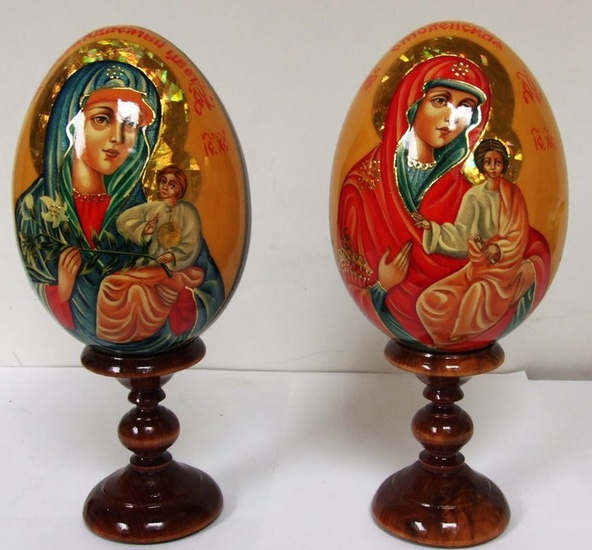Religious objects - Russian lacquer wooden eggs (2) - Wood - 1990-2000
Russian lacquer wooden eggs hand painted Icon Fadeless Flowers and Mother of God – Smolenskaya- tempera signed vintage
Eggs - (13,20 см) x (9,7cm)
wood stands (7,70 см)
completely handmade tempera coated with varnish - therefore not subject to fading from direct sunlight
The egg depicts the icon of the Fadeless Flowers of the Mother of God
inscriptions in Russian and Greek
Comes to the church like the Lady,
And everyone has a Queen,
Heavenly and earthly beautiful Maiden,
how with His luminous omophorion
And heavenly choir Cover people with Your honest veil
Icon of the Blessed Virgin Mary called “Hodegetria-Smolensk”
I don’t know how the translation of Old Church Slavonic into English came about
on the base of the eggs the signature of the artist
note:
in the icon field at the height of the Baby’s right arm there is a small defect measuring 3x7mm
the tempera did not merge
For Gregory Palamas and many other church fathers, the Mother of God was the most beautiful example of human virtues - an ethical and aesthetic ideal that ancient thought was looking for throughout its pre-Christian history. Her impassive conception by the aged righteous, the perfect humility of the Ever-Virgin and Her holy parents before the will of the Lord, the Church opposed the orgiastic principle of the pagan mother goddess. The attempts of ancient philosophy to compete with Christian theology were defeated: the Neoplatonists, the last representatives of the pagan love of wisdom, could not overcome gravity, and the concept of the circulation of souls became the crown of their creativity. The Theotokos dogma, firmly embedded in the doctrine of God's economy and the personal salvation of the soul, freed Byzantine thought from the yoke of stochastic matter. In this aesthetically sophisticated form, ready for complex polemics with opponents skilled in rhetoric, Orthodoxy came to Russia.
The icon of the Most Holy Theotokos called “Hodegetria-Smolensk” has been known in Rus' since ancient times. Under what circumstances this icon appeared in Rus', sufficiently clear information has not been preserved. The icon of the Mother of God called “Smolensk” is a copy of the “Hodegetria-Blachernae”, written according to legend by the holy evangelist and apostle Luke. [1] According to church tradition, one day the Mother of God, appearing to two blind men, led them to the Blachernae Church, and placing them in front of Her icon, she gave them sight. Since then, the icon began to be called “Hodegetria”, which translated from Greek means “Guide”. There is also another explanation for the name of this icon. According to one of the legends, which reports that the Greek emperor Constantine Monomakh the Porphyrogenitus (1042-1054) blessed his daughter Anna Monomakhina with this icon, marrying her in 1046 to the Chernigov prince Vsevolod, the son of Yaroslav the Wise. Since this icon accompanied Princess Anna on her journey from Constantinople to Chernigov and the icon itself received the name “Hodegetria” (“Guide”)
View it on
Estimate
Time, Location
Auction House
Russian lacquer wooden eggs hand painted Icon Fadeless Flowers and Mother of God – Smolenskaya- tempera signed vintage
Eggs - (13,20 см) x (9,7cm)
wood stands (7,70 см)
completely handmade tempera coated with varnish - therefore not subject to fading from direct sunlight
The egg depicts the icon of the Fadeless Flowers of the Mother of God
inscriptions in Russian and Greek
Comes to the church like the Lady,
And everyone has a Queen,
Heavenly and earthly beautiful Maiden,
how with His luminous omophorion
And heavenly choir Cover people with Your honest veil
Icon of the Blessed Virgin Mary called “Hodegetria-Smolensk”
I don’t know how the translation of Old Church Slavonic into English came about
on the base of the eggs the signature of the artist
note:
in the icon field at the height of the Baby’s right arm there is a small defect measuring 3x7mm
the tempera did not merge
For Gregory Palamas and many other church fathers, the Mother of God was the most beautiful example of human virtues - an ethical and aesthetic ideal that ancient thought was looking for throughout its pre-Christian history. Her impassive conception by the aged righteous, the perfect humility of the Ever-Virgin and Her holy parents before the will of the Lord, the Church opposed the orgiastic principle of the pagan mother goddess. The attempts of ancient philosophy to compete with Christian theology were defeated: the Neoplatonists, the last representatives of the pagan love of wisdom, could not overcome gravity, and the concept of the circulation of souls became the crown of their creativity. The Theotokos dogma, firmly embedded in the doctrine of God's economy and the personal salvation of the soul, freed Byzantine thought from the yoke of stochastic matter. In this aesthetically sophisticated form, ready for complex polemics with opponents skilled in rhetoric, Orthodoxy came to Russia.
The icon of the Most Holy Theotokos called “Hodegetria-Smolensk” has been known in Rus' since ancient times. Under what circumstances this icon appeared in Rus', sufficiently clear information has not been preserved. The icon of the Mother of God called “Smolensk” is a copy of the “Hodegetria-Blachernae”, written according to legend by the holy evangelist and apostle Luke. [1] According to church tradition, one day the Mother of God, appearing to two blind men, led them to the Blachernae Church, and placing them in front of Her icon, she gave them sight. Since then, the icon began to be called “Hodegetria”, which translated from Greek means “Guide”. There is also another explanation for the name of this icon. According to one of the legends, which reports that the Greek emperor Constantine Monomakh the Porphyrogenitus (1042-1054) blessed his daughter Anna Monomakhina with this icon, marrying her in 1046 to the Chernigov prince Vsevolod, the son of Yaroslav the Wise. Since this icon accompanied Princess Anna on her journey from Constantinople to Chernigov and the icon itself received the name “Hodegetria” (“Guide”)



